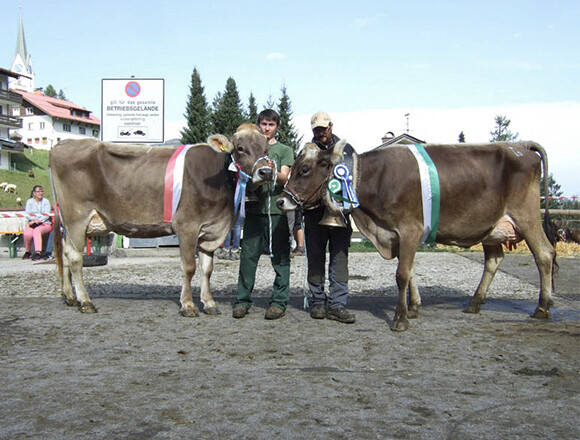

Bovine Beauty Contest
Although the cattle award ceremony is by no means as glamorous as the Paris catwalks, it still has its own intrinsic qualities alongside the more superficial ones.
Although the cattle award ceremony is by no means as glamorous as the Paris catwalks, it still has its own intrinsic qualities alongside the more superficial ones.
The cows are usually called something like Flora, Flieder or Fröhlich and they and their relatives represent the typical picture postcard motif of Kleinwalsertal. This breed of cow is called the original Braunvieh (brown cattle) which is classified as a rare breed. Every year at the Viehprämierung (cattle award ceremony), a jury from the Vorarlberg Brown Cattle Breeders’ Association decides which are the best and most beautiful cows of this breed in Kleinwalsertal. On the first Saturday in October, around 100 animals are eyed critically, admired and evaluated in Hirschegg. What is actually considered as ‘beauty’ and ‘merit’ in the eyes of the cattle breeders?
The individual groups are then shown in the cattle ring where the experts can take a really close look at them. How good is the animal’s structure, including size, length, volume and musculature? What type of shape are their shoulders, back, pelvis and feet? How are their udders and teats arranged?
More Cattle Breeding Terminology
When the thorough physical examinations have finished, the animals are lined up and the winner of each group is selected. Which animal belongs to which group is clearly specified.
Dauerleistungskühe, for example, are cows which have continously produced at least 50,000 kg of milk in their life. As a basic rule, the more calves a cow has, the more milk she will produce during her life. Older cattle are at least six years old. Young cattle are less than six years old and have already calved twice. Heifers are young female cows who have borne one cow and who have started to lactate (produced milk for the first time). Kalbinnen are heifers who are in-calf and who are older than two years or cows who have calved before the 1st of July of the same year. Two-year olds are breeding cows who are younger than two years. A family of cows is considered to be a breeding family if it at least two direct descendants of a cow can be presented. A winner is naturally chosen from a selection of calves which are presented by a group of young and proud breeders. All prize winners receive a coveted winner’s ribbon. The overall winner of the day travels to Dornbirn to be judged at the state championship.



Share page...
...and tell others